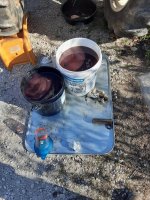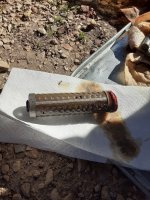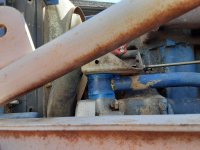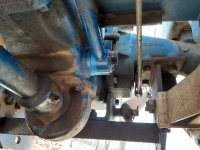Scotty,
Both hydraulic lines are steel, from pump to hyd tank.
I checked the hyd fluid level today and its full, to within 2" of the threads of the fill plug. I also put a clean paint stick in the fill hole, to the bottom of the hyd tank/reservoir, and the fluid is clean, clean, and looks brand new. Even wiped it with a clean white rag and no sign of dirt, color, or stringiness from water intrusion.
I then pipe doped the fill plug threads to keep water out. I do have new fluid ready if needed, but I sure would hate to waste whats in it. My manual calls for 13.1 quarts, or about 3.25 gallons.
I obviously haven't pulled the filter screen yet and the only replacement filter I can find is $239.00 + tax/shipping for the Satoh Bull.
Since the screen and access/drain are on the lower side of, but not the bottom of, the hyd tank, I'm assuming any gunk or debris will remain on the bottom of the hyd tank. Could i do a brief test run of the hyd pump with the screen pulled, access cover/gasket replaced, and fluid topped off? With no obstruction on the suction feed, i.e., filter screen removed, the hyd pump should raise and tilt the loader quickly and actually have lifting power. My issue is a lifting/tilting power issue with a load on the bucket. It raises and tilts fine, albeit a little slow, empty and unladen. Assuming the filter screen is in good shape, then my next suspect would be the hyd pump.
I'm just asking your thoughts on the above test, and I don't plan on trying it as I realize I could potentially grenade the hydraulic pump if some solid debris were to get pulled through it.
Next thing I plan on doing this weekend is to cleanup the 4 ends of the hyd pressure/suction lines, and the scuff them and apply copious amounts of blue permatex and allow to dry for 24 hours and then test to see if that healed any suction leaks.
Thanks again!
Both hydraulic lines are steel, from pump to hyd tank.
I checked the hyd fluid level today and its full, to within 2" of the threads of the fill plug. I also put a clean paint stick in the fill hole, to the bottom of the hyd tank/reservoir, and the fluid is clean, clean, and looks brand new. Even wiped it with a clean white rag and no sign of dirt, color, or stringiness from water intrusion.
I then pipe doped the fill plug threads to keep water out. I do have new fluid ready if needed, but I sure would hate to waste whats in it. My manual calls for 13.1 quarts, or about 3.25 gallons.
I obviously haven't pulled the filter screen yet and the only replacement filter I can find is $239.00 + tax/shipping for the Satoh Bull.
Since the screen and access/drain are on the lower side of, but not the bottom of, the hyd tank, I'm assuming any gunk or debris will remain on the bottom of the hyd tank. Could i do a brief test run of the hyd pump with the screen pulled, access cover/gasket replaced, and fluid topped off? With no obstruction on the suction feed, i.e., filter screen removed, the hyd pump should raise and tilt the loader quickly and actually have lifting power. My issue is a lifting/tilting power issue with a load on the bucket. It raises and tilts fine, albeit a little slow, empty and unladen. Assuming the filter screen is in good shape, then my next suspect would be the hyd pump.
I'm just asking your thoughts on the above test, and I don't plan on trying it as I realize I could potentially grenade the hydraulic pump if some solid debris were to get pulled through it.
Next thing I plan on doing this weekend is to cleanup the 4 ends of the hyd pressure/suction lines, and the scuff them and apply copious amounts of blue permatex and allow to dry for 24 hours and then test to see if that healed any suction leaks.
Thanks again!




